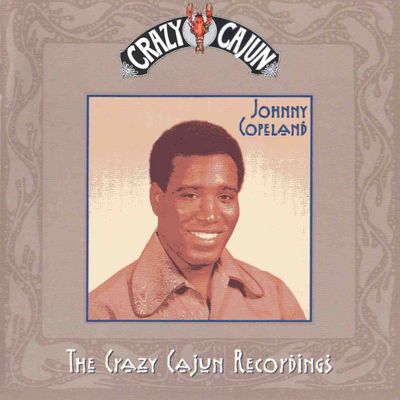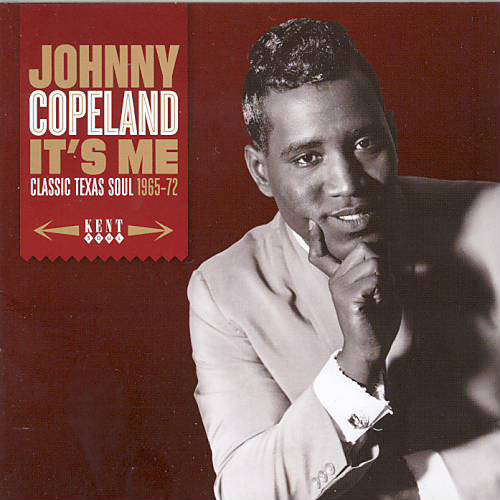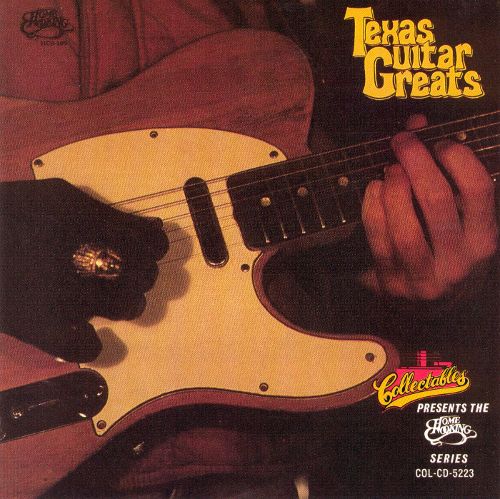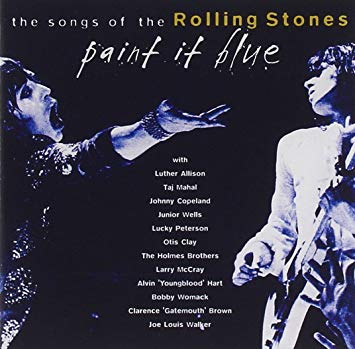John Clyde Copeland
b. March 27th, 1937 in Haynesville (Louisiana)
d. June 30th, 1997 in Houston (Texas)




I'LL BE AROUND
Mr R&B
February 1958 - 1972
HOUSTON ROOTS
Ace
August 1960 - August 1967
WORKING MAN'S BLUES
Fuel 2000
August 1960 - August 1967
THE COPELAND COLLECTION
Home Cooking
August 1960 - August 1968
Né en Louisiane, de parents métayers, Johnny grandit à Magnolia dans l'Arkansas puis arrive à 13 ans à Houston. Entretemps, son père lui a laissé sa guitare. Son influence majeure reste le grand guitariste texan T-Bone Walker. Il forme les Duke of Rhythm son premier groupe avec le guitariste Joe Hughes. Rapidement, Johnny devient un des bluesmen les plus en vue du Third Ward de Houston (jouant sur les scènes du Shady's Playhouse et du Eldorado Ballroom). Il accompagne Clarence Samuels chez Excello en 1956 ("Chicken hearted woman"). A Houston, il signe avec la firme Duke de Don Robey mais malheureusement ce contrat ne débouchera sur aucune séance d'enregistrement. Grâce au disc-jockey de la radio KCOH Clifford "King Bee" Smith, Johnny grave pour Mercury un premier simple en février 1958 sous la supervision du producteur Bob Shad. Puis, en aout 1960, pour All Boy, il enregistre une poignée de titres de Rhythm & Blues texan comme "Hear what I said" et l'instrumental "Late hours" sous la supervision du producteur Steve Poncio. Ensuite, pour le label Golden Eagle de Charlie Booth, Johnny décroche son premier succès régional avec "Down on bending knees" et quelques excellents titres : "Just one more time", "Mama told me" et le superbe "Working man's blues".
Born in Louisiana, Johnny grew up in Magnolia, Arkansas, and then arrived at 13 in Houston. Meanwhile, his father left him his guitar. His major influence remains the great Texas guitarist T-Bone Walker. He forms the Duke of Rhythm his first group with guitarist Joe Hughes. Quickly, Johnny becomes one of the most prominent bluesmen of Houston's Third Ward (playing on Shady's Playhouse and Eldorado Ballroom stages). He accompanies Clarence Samuels at Excello in 1956 ("Chicken hearted woman"). In Houston, he signs with Don Robey's Duke label, but unfortunately this contract do not lead to a recording session. Thanks to KCOH radio DJ's Clifford "King Bee" Smith, Johnny cuts for Mercury a first single in february 1958 under the supervision of producer Bob Shad. Then, in august 1960, for All Boy, he recorded a handful of Texas Rhythm & Blues titles like "Hear what I said" and the instrumental "Late hours" under the supervision of producer Steve Poncio. Then, for Charlie Booth's Golden Eagle label, Johnny reach his first regional success with "Down on bending knees" and some excellent titles : "Just one more time", "Mama told me" and the superb "Working man's blues".

GHETTO CHILD
Indigo
August 1960 - 1990



JOHNNY COPELAND SINGS THE BLUES
Crazy Cajun
September 1963 - 1966
THE CRAZY CAJUN RECORDINGS
Edsel
September 1963 - 1973
IT'S ME : CLASSIC SOUL RECORDINGS
Kent Soul
September 1964 - 1972
DEDICATED TO THE GREATEST
Kent
1964 - 1966 / 1971 - 1972
Sous l'impulsion du producteur Huey P. Meaux, Johnny enregistre pour Crazy Cajun (un label appartenant à Meaux) mais aussi pour Wand, Jet Stream ("It's my own tears that's being wasted"), Suave, Bragg, Boogaloo. Dans ces disques sont rassemblées ces séances fort inégales. A cette époque, Johnny hésitait entre plusieurs styles : Rhythm & Blues, Blues, Soul. On peut retenir les Blues "Stealin'", "Working man's blues" mais certaines ballades surannées apparaissent en revanche parfaitement ennuyeuses. Les titres les plus Soul comme "Something you got" et "Four dried beans" méritent l'écoute. On peut signaler aussi qu'à la même époque, il grave une poignée de titres pour Atlantic sous la supervision de Bob Mac Ree puis quelques pistes pour Kent au début des années 70.
Under the leadership of producer Huey P. Meaux, Johnny records for Crazy Cajun (a label owned by Meaux) but also for Wand, Jet Stream ("It's my own tears that's being wasted"), Suave, Bragg, Boogaloo. In these albums are collected these very uneven sessions. At that time, Johnny was hesitating between several styles : Rhythm & Blues, Blues, Soul. We can retain the blues tracks "Stealin'", "Working man's blues" but some old-fashioned ballads appear on the other hand perfectly boring. The most Soul titles like "Something you got" and "Four dried beans" are worth listening to. It can also be noted that at the same time, he cut a handful of titles for Atlantic under the supervision of Bob Mac Ree and some tracks for Kent in the early 70's.

BACK AGAINST THE WALL
Collectables
August 1968

TEXAS GUITAR GREATS vol.2
Collectables
August 1968
Dans cette anthologie de titres Home Cooking, on trouve un bon "Traveling man" joué par Johnny Copeland.
In this anthology of Home Cooking titles, there is a good "Traveling man" played by Johnny Copeland.

THE THREE SIDES OF JOHNNY CLYDE COPELAND
Collectables
1971 / 1981 / 1988 - 1989

COPELAND SPECIAL
Rounder
Demon
Black & Blue
Amigo
1980 - 1981
Quittant Houston et le Sud, Johnny s'installe à New York en 1974. Grâce au producteur Dan Doyle, il signe chez Rounder. Ce premier album pour ce label permit à Johnny Copeland de relancer sa carrière. Produit par Doyle, Johnny s'affirme ici comme un excellent chanteur à la voix passionnée. Sa guitare est mordante et incisive. Derrière lui, on remarque une belle section cuivres composée notamment de George Adams, Arthur Blythe, Bayard Lancaster, Joe Rigby et Garrett List. On note aussi les participations de l'harmoniciste Brooklyn Slim (alias Paul Oscher) et du pianiste-arrangeur Ken Vangel. "I wish I was single", "Everybody wants a piece of me", "Copeland special", "It's my own tears that's being wasted", "Done got over it", "Down on bended knees" sont des pistes absolument remarquables.
Leaving Houston and the South, Johnny moved to New York in 1974. Thanks to producer Dan Doyle, he signed with Rounder. This first album for this label allowed Johnny Copeland to revive his career. Produced by Doyle, Johnny asserts himself here as an excellent singer with a passionate voice. His guitar is biting and incisive. Behind him, there is a beautiful horn section including George Adams, Arthur Blythe, Bayard Lancaster, Joe Rigby and Garrett List. We also note appearances of harmonica player Brooklyn Slim (aka Paul Oscher) and pianist-arranger Ken Vangel. "I wish I was single", "Everybody wants a piece of me", "Copeland special", "It's my own tears that's being wasted", "Done got over it", "Down on bended knees" are absolutely remarkable tracks .

MAKE MY HOME WHERE I HANG MY HAT
Rounder
Demon
Black & Blue
Amigo
1982
Second album pour Rounder dans la parfaite continuité de "Copeland special" : mêmes producteurs et arrangeurs et presque les mêmes musiciens. Encore une fois, le résultat est étincelant. De nombreuses pépites parsèment ce disque indispensable : "Natural born believer", "Make my home where I hang my hat", "Cold outside", "Love utopia", "Old man blues".
Second album for Rounder in the perfect continuity of "Copeland special" : same producers and arrangers and almost the same musicians. Once again, the result is sparkling. Indispensable album dotted with numerous gems : "Natural born believer", "Make my home where I hang my hat", "Cold outside", "Love utopia", "Old man blues".

TEXAS TWISTER
Rounder
Demon
Black & Blue
Amigo
1982
Pour ce troisième opus chez Rounder - peut-être un moins intense que sur les deux livraisons précédentes - Johnny brille à la guitare sur "Houston", "I de go now", "When the rain starts fallin'". On note aussi les apparitions de Stevie Ray Vaughan et du jazzman Archie Shepp. Attention, il existe des versions CD sous le nom "Texas twister" qui ne sont en fait que des compilations de ses faces Rounder.
For this third opus at Rounder - perhaps a less intense than on the previous two installment - Johnny shines on guitar on "Houston", "I de go now", "When the rain starts fallin'". We also see appearances of Stevie Ray Vaughan and jazzman Archie Shepp. Be careful, there are CD versions under the name "Texas twister" which are in fact only compilations of his Rounder sides.

BRINGIN' IT ALL BACK HOME
Rounder
Demon
Black & Blue
Amigo
1985
Johnny Copeland avait fait une tournée marquante en Afrique de l'Ouest en 1982 (il en fera une autre en 1987). Souhaitant travailler avec des musiciens locaux, il enregistre cet album sur le continent africain (à Abidjan en Côte d'Ivoire). Johnny mêle son Blues avec des instruments et des rythmes africains. On entend notamment Djeli Moussa Diawara à la cora. "Kasavubu", "Ngote", "Abidjan", "Same thing" explorent ce style de blues africain avec un certain bonheur. Une démarche résolument originale qu'il convient de saluer.
Johnny Copeland made a prominent tour of West Africa in 1982 (he will do another one in 1987). Wishing to work with local musicians, he recorded this album on the African continent (in Abidjan in Ivory Coast). Johnny mixes his Blues with African instruments and rhythms. We hear Djeli Moussa Diawara at the cora. "Kasavubu", "Ngote", "Abidjan", "Same thing" explore this style of African blues with some success. A resolutely original approach that should be saluted.

SHOWDOWN
Alligator
Sonet
August - September 1985
Enregistrée aux Streeterville Studios de Chicago, cette mythique réunion de trois grands guitaristes - Albert Collins, Robert Cray et Johnny Copeland - a laissé une empreinte indélébile dans le Blues des années 80. Les producteurs Bruce Iglauer et Dick Shurman ont parfaitement équilibré les interventions des trois musiciens. Accompagnés par des sidemen de premier choix (Allen Batts, Johnny B. Gayden, Casey Jones), ils se complètent merveilleusement. Johnny brille notamment sur "Bring your fine self home", "T-Bone shuffle" et "Black cat bone".
Recorded in Streeterville Studios in Chicago, this mythical meeting of three great guitarists - Albert Collins, Robert Cray and Johnny Copeland - left an indelible mark in the Blues of the 80's. Producers Bruce Iglauer and Dick Shurman perfectly balanced the interventions of the three musicians. Accompanied by first rate sidemen (Allen Batts, Johnny B. Gayden, Casey Jones), they complement each other wonderfully. Johnny shines especially on "Bring your fine self home", "T-Bone shuffle" and "Black cat bone".

ALLIGATOR 25TH ANNIVERSARY COLLECTION
Alligator
Sonet
August - September 1985
Dans cette compilation, on trouve "Something to remember you by" - un morceau issu des séances de "Showdown" - qu'Albert joue en compagnie de Johnny Copeland.
In this compilation, we find "Something to remember you by" - a track from the "Showdown" sessions - that Albert plays with Johnny Copeland.

AIN'T NOTHIN' BUT A PARTY
Rounder
June 1987
Album live capté au Juneteenth Festival de Houston. L'ambiance est surchauffée dès les premières minutes et jusqu'à la fin. Johnny semble en excellente forme au chant et à la guitare. On remarque également le jeu de saxophone puissant de Bert Mac Gowan.
Live album captured at Juneteenth Festival in Houston. The atmosphere is overheated from the first minutes until the end. Johnny seems in excellent shape on vocals and guitar. We also note the powerful saxophone playing of Bert Mac Gowan.


AT HIS BEST
MIL Multimedia
BLUES POWER
P-Vine
1987
Ces disques sont en fait des compilations mais contiennent quatre morceaux live inédits datant de 1987. On retient en particulier "You got me singing a love song" et "Texas party".
These albums are actually compilations but contain four unissued live tracks from 1987. In particular, we can point out "You got me singing a love song" and "Texas party".

TEXAS GUITAR GREATS
Home Cooking
April 1988
Un titre live inédit capturé lors d'un festival à San Antonio (le furieux "Come on y'all").
An unreleased live track captured during a festival in San Antonio (the furious "Come on y'all").

BOOM BOOM
Rounder
1989
Dernier album pour le label Rounder après dix années de collaboration, il est produit par Dan Doyle et Ken Vangel. Cette livraison manque un peu de flamme et d'inspiration comparée aux précédentes. Néanmoins, on trouve quelques bons moments comme "Texas party", "Flamin' Mamie", "Cut off my right arm", "Blues ain't nothin'".
Last album for the Rounder label after ten years of collaboration, it is produced by Dan Doyle and Ken Vangel. This installment lacks a bit of flame and inspiration compared to previous ones. Nevertheless, there are some good moments like "Texas party", "Flamin' Mamie", "Cut off my right arm", "Blues ain't nothin'".


FURTHER ON UP THE ROAD
Aim
LIVE IN AUSTRALIA
Black Top
June - July 1990
Album live capté pendant sa tournée australienne de juin-juillet 1990. Johnny et son groupe apparaissent en pleine forme délivrant un set enflammé et accrocheur. On retient particulièrement des versions puissantes de "Further on up the road", "Cut off my right arm", "Nobody but you", "Learned my lesson".
Live album captured during his australian tour of june-july 1990. Johnny and his band appear in great shape delivering a burning and catchy set. We can particularly point out powerful versions of "Further on up the road", "Cut off my right arm", "Nobody but you", "Learned my lesson".

SATURDAY NIGHT AT ROCKEFELLER'S
Collectables
October 1990

FLYIN' HIGH
Verve - Gitanes Jazz
March - September 1991
Gravé entre la Belgique et New York, cet album présente Johnny avec son groupe régulier et de nombreux invités : son ami d'enfance Joe "Guitar" Hughes, The Uptown Horns, Calvin Owens, Dr John, David "Fathead" Newman, Buckwheat Zydeco. Malgré cet assemblage de talents, l'album souffre d'arrangements trop lourds et manque de spontanéité. On peut ressortir néanmoins "Flyin' high", "San Antone", "Thigpen" et "Circumstances". Production de Johnny Copeland et John Hahn.
Recorded between Belgium and New York, this album presents Johnny with his regular band and many guests : his childhood friend Joe "Guitar" Hughes, The Uptown Horns, Calvin Owens, Dr. John, David "Fathead" Newman, Buckwheat Zydeco . Despite this combination of talents, the album suffers from too heavy arrangements and lacks spontaneity. We can stand out nevertheless "Flyin' high", "San Antone", "Thigpen" and "Circumstances". Production by Johnny Copeland and John Hahn.

STRIKE A DEEP CHORD : BLUES GUITARS FOR THE HOMELESS
Justice
1992

CATCH UP WITH THE BLUES
Verve - Gitanes Jazz
April - May 1993
Comme pour son précédent opus, on trouve ici beaucoup d'invités : Joe "Guitar" Hughes, Lonnie Brooks, Clarence "Gatemouth" Brown et les Memphis Horns. "Catch up with the blues" et "Rolling with the pinches" lancent parfaitement l'album. On retient aussi "Cold cold winter", "The grammy song" et "Rain". Production de John Snyder.
As with his previous album, there are many guests here : Joe "Guitar" Hughes, Lonnie Brooks, Clarence "Gatemouth" Brown and the Memphis Horns. "Catch up with the blues" and "Rolling with the pinches" perfectly launch the album. We also remark "Cold cold winter", "The grammy song" and "Rain". Production by John Snyder.

TRUE BLUE
Sawdust Alley
1993

JUNGLE SWING
Verve - Gitanes Jazz
January - March 1995
Fin 1994, on lui diagnostique une malformation cardiaque qui l'oblige à subir de nombreux traitements médicaux. Malgré cela, il propose son troisième album pour Verve - Gitanes Jazz. Johnny renoue ici avec ses influences africaines (à travers les percussions de Kimati Dinizulu) comme dans "Bringin' it all back home". Beaucoup de moments intenses comme le pur blues "Blues ain't nothin'", "Kasavubu" et ses percussions africaines, "Jungle swing" et ses choeurs émouvants et aussi "Same thing" et "Abidjan". Un album très consistant et vraiment original produit par John Snyder. Après une transplantation cardiaque en janvier 1997, il décède quelques mois plus tard à Houston. Avec sa femme Ethel Lee Copeland, il eut un fils et trois filles. Sa fille Shemekia Copeland est une célèbre chanteuse de blues.
At the end of 1994, he was diagnosed with a cardiac malformation that forced him to undergo numerous medical treatments. Despite this, he offers his third album for Verve - Gitanes Jazz. Johnny revives here with his African influences (through the percussion of Kimati Dinizulu) as in "Bringin' it all back home". A lot of intense moments like pure blues "Blues ain't nothin'", "Kasavubu" and his African percussions, "Jungle swing" and his moving choirs and also "Same thing" and "Abidjan". A very consistent and really original album produced by John Snyder. After a heart transplant in january 1997, he died a few months later in Houston. With his wife Ethel Lee Copeland, he had a son and three daughters. His daughter Shemekia Copeland is a famous blues singer.


PAINT IT BLUE : SONGS OF THE ROLLING STONES
House of Blues
Ruf
1997
Dans cet hommage aux Rolling Stones joué par des bluesmen, Johnny reprend "Tumbling dice" en compagnie de Derek Trucks et de sa fille Shemekia.
In this tribute to Rolling Stones played by bluesmen, Johnny covers "Tumbling dice" with Derek Trucks and his daughter Shemekia.